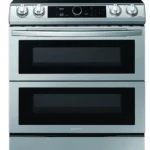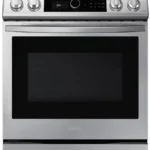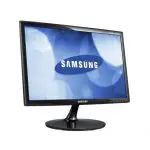
Samsung RF265 and RS267 models side-by-side refrigerator error codes
These error code explanations can help you diagnose a problem with Samsung RS265TD and RS267TD side-by-side refrigerators. For how-to information, visit the PartsDirect repair help section, which includes DIY help for major appliances, lawn and garden equipment, garage door openers, vacuum cleaners and more. Search for your model number to find a complete list of replacement parts for your refrigerator.
This type of refrigerator displays an error code on the freezer and refrigerator temperature digital displays when the control detects a component failure. The freezer temperature display shows the number designation of the code and the refrigerator temperature display shows E.
When the control detects a communication error between the control panel and the electronic control board, the freezer temperature display shows Er and the refrigerator display shows Pc.
Refer to the chart below to find the cause of the error code and get troubleshooting advice to clear the code.
The refrigerator may work properly even though the control displays an error code. A power outage can sometimes cause the control to detect a problem and display a code. The control may continue to display the code even if the component failure no longer exists. To reset the display so it shows freezer and refrigerator temperatures, press and hold the Energy Saver and Lighting buttons simultaneously for 8 seconds. The error code will disappear and the display will resume normal operations.
If the code reappears on the display, follow the troubleshooting steps in the chart below to fix the problem being detected and clear the code.
If you cleared an error code from the display and encounter cooling problems in the refrigerator, the component problem that caused the code likely still exists even though you cleared the code. You can redisplay a detected error code by pressing and holding the Energy Saver and Lighting buttons simultaneously for 8 seconds. The display will chime and display the code for 30 seconds. The display will then revert back to showing freezer and refrigerator temperatures.
Follow the troubleshooting steps described for the code to fix the component failure and clear the code.
| Error Code | Condition | DIY Advice |
| 1 E | Freezer temperature sensor failure | Check/Repair
Unplug the refrigerator and check the wire harness connection on the freezer temperature sensor. Reconnect the wire harness if it’s loose. If the wire harness connection is okay, check sensor resistance using a multimeter. The meter should measure about 5,600 ohms if the sensor temperature is 72 degrees (room temperature), 13,290 ohms at 32 degrees and 29,000 ohms at 0 degrees. Replace the temperature sensor if resistance is off by more than 10 percent. If sensor resistance is okay, reinstall the temperature sensor and check the sensor’s wire harness connections to the electronic control board (gray wire on pin 4 and yellow wire on pin 5 of CN40). Reconnect the wires if loose. If the wire connections are okay, disconnect the sensor wires from the electronic control board and measure resistance through the sensor’s wires. The meter should read the same resistance as for the temperature sensor. If the meter measures correct sensor resistance through the wires, you’ll likely need to replace the electronic control board because it’s not accurately detecting sensor resistance. Find and repair the sensor wiring failure if the meter measures infinite resistance through the sensor wires. How-to helpHow to replace a refrigerator thermistorPossible partsFreezer temperature sensor, Electronic control board |
| 2 E | Refrigerator compartment temperature sensor failure | Check/Repair
Unplug the refrigerator and check the wire harness connection on the refrigerator compartment temperature sensor. Reconnect the wire harness if it’s loose. If the wire harness connection is okay, check sensor resistance using a multimeter. The meter should measure about 5,600 ohms if the sensor temperature is 72 degrees (room temperature), 13,290 ohms at 32 degrees and 11,700 ohms at 37 degrees. Replace the temperature sensor if resistance is off by more than 10 percent. If sensor resistance is okay, reinstall the temperature sensor and check the sensor’s wire harness connections to the electronic control board (black wire and gray wire on CN40). Reconnect the wires if loose. If the wire connections are okay, disconnect the sensor wires from the electronic control board and measure resistance through the sensor’s wires. The meter should read the same resistance as for the temperature sensor. If the meter measures correct sensor resistance through the wires, you’ll likely need to replace the electronic control board because it’s not accurately detecting sensor resistance. Find and repair the sensor wiring failure if the meter measures infinite resistance through the sensor wires. How-to helpHow to replace a refrigerator thermistorPossible partsRefrigerator compartment temperature sensor, Electronic control board |
| 4 E | Freezer evaporator defrost temperature sensor failure | Check/Repair
Unplug the refrigerator and check the wire harness connection on the freezer evaporator defrost temperature sensor. Reconnect the wire harness if it’s loose. If the wire harness connection is okay, check sensor resistance using a multimeter. The meter should measure about 5,600 ohms if the sensor temperature is 72 degrees (room temperature), 13,290 ohms at 32 degrees and 29,000 ohms at 0 degrees. Replace the temperature sensor if resistance is off by more than 10 percent. If sensor resistance is okay, reinstall the temperature sensor and check the sensor’s wire harness connections to the electronic control board (blue wire and gray wire on CN40). Reconnect the wires if loose. If the wire connections are okay, disconnect the sensor wires from the electronic control board and measure resistance through the sensor’s wires. The meter should read the same resistance as for the temperature sensor. If the meter measures correct sensor resistance through the wires, you’ll likely need to replace the electronic control board because it’s not accurately detecting sensor resistance. Find and repair the sensor wiring failure if the meter measures infinite resistance through the sensor wires. Possible partsFreezer evaporator defrost temperature sensor, Electronic control board |
| 5 E | Refrigerator evaporator defrost temperature sensor failure | Check/Repair
Unplug the refrigerator and check the wire harness connection on the refrigerator evaporator defrost temperature sensor. Reconnect the refrigerator evaporator defrost temperature sensor wire harness if it’s loose. If the wire harness connection is okay, check sensor resistance using a multimeter. The meter should measure about 5,600 ohms if the sensor temperature is 72 degrees (room temperature) and 13,290 ohms at 32 degrees. Replace the temperature sensor if resistance is off by more than 10 percent. If sensor resistance is okay, reinstall the temperature sensor and check the sensor’s wire harness connections to the electronic control board (purple wire and gray wire on CN40). Reconnect the wires if loose. If the wire connections are okay, disconnect the sensor wires from the electronic control board and measure resistance through the sensor’s wires. The meter should read the same resistance as for the temperature sensor. If the meter measures correct sensor resistance through the wires, you’ll likely need to replace the electronic control board because it’s not accurately detecting sensor resistance. Find and repair the sensor wiring failure if the meter measures infinite resistance through the sensor wires. Possible partsRefrigerator evaporator defrost temperature sensor, Electronic control board |
| 6 E | Ambient temperature sensor failure | Check/Repair
Unplug the refrigerator and check the wire harness connection on the ambient temperature sensor. Reconnect the wire harness if it’s loose. If the wire harness connection is okay, check sensor resistance using a multimeter. The meter should measure about 5,600 ohms if the sensor temperature is 72 degrees (room temperature). Replace the temperature sensor if resistance is off by more than 10 percent. If sensor resistance is okay, reinstall the temperature sensor and check the sensor’s wire harness connections to the electronic control board (yellow wires on pins 1 and 2 of CN40). Reconnect the wires if loose. If the wire connections are okay, disconnect the sensor wires from the electronic control board and measure resistance through the sensor’s wires. The meter should read the same resistance as for the temperature sensor. If the meter measures correct sensor resistance through the wires, you’ll likely need to replace the electronic control board because it’s not accurately detecting sensor resistance. Find and repair the sensor wiring failure if the meter measures infinite resistance through the sensor wires. Possible partsAmbient temperature sensor, Electronic control board |
| 21 E | Freezer evaporator fan failure | Check/Repair
Unplug the refrigerator and check the wire harness connections on the freezer evaporator fan. Reconnect any loose wires. Check for evaporator frost and ice buildup that can block fan blade rotation. Defrost any ice buildup from the evaporator. Check the freezer evaporator fan wiring connections (yellow, gray and black wires) on the CN75 electronic control board connector. Reconnect any loose wires. If the wiring connections are okay, replace the freezer evaporator fan. Possible partsFreezer evaporator fan |
| 22 E | Refrigerator evaporator fan failure | Check/Repair
Unplug the refrigerator and check the wire harness connections on the refrigerator evaporator fan. Reconnect any loose wires. Check for evaporator frost and ice buildup that can block fan blade rotation. Defrost any ice buildup from the evaporator. Check the refrigerator evaporator fan wiring connections (orange, gray and brown wires) on the CN75 electronic control board connector. Reconnect any loose wires. If the wiring connections are okay, replace the refrigerator evaporator fan. How-to helpHow to replace an evaporator fan motor in a side-by-side refrigeratorPossible partsRefrigerator evaporator fan |
| 23 E | Condenser fan failure | Check/Repair
Unplug the refrigerator and check the wire harness connections on the condenser fan. Reconnect any loose wires. Check for and remove an obstruction that could block the condenser fan blade from spinning. Check the condenser fan wiring connections (sky blue, gray and red wires) on the CN75 electronic control board connector. Reconnect any loose wires. If the wiring connections are okay, replace the refrigerator evaporator fan. Possible partsCondenser fan |
| 24 E | Freezer evaporator defrost system failure | Check/Repair
Unplug the refrigerator and remove the electronic control board cover. Using a multimeter, check the resistance through the brown wire and the orange wire on the CN70 control board connector. If the meter measures about 66 ohms, then the defrost heater, bi-metal thermostat and thermal fuse are good. Check the freezer evaporator defrost temperature sensor as described in troubleshooting for the 4 E error code. Replace the freezer evaporator defrost temperature sensor if it’s bad. If the sensor is good, then you may need to replace the electronic control board because the board isn’t sending electric current to the defrost heater. If the meter measures infinite resistance through the brown and orange wires on CN70, then a wiring break or a failed component in the defrost circuit is preventing the defrost system from heating. First, check resistance through the defrost heater. The meter should measure about 66 ohms through the defrost heater. Replace the defrost heater if the meter measures infinite resistance through the defrost heater. If the defrost heater is good, check the resistance through the defrost bi-metal thermostat. The meter should measure near 0 ohms of resistance through the defrost bi-metal thermostat. Replace the bi-metal thermostat if the meter measures infinite resistance. If the defrost heater and bi-metal thermostat are both okay, check resistance through the thermal fuse. The meter should measure near 0 ohms of resistance through the thermal fuse. Replace the thermal fuse if the meter measure infinite resistance. If the defrost heater, bi-metal thermostat and thermal fuse are all good, find and repair the wiring break in the defrost circuit that’s preventing the defrost heater from getting electrical current through the defrost system circuit and causing the infinite resistance reading through the brown and orange wires on CN70. Possible partsFreezer defrost heater, Freezer defrost bi-metal thermostat, Freezer evaporator defrost temperature sensor, Electronic control board |
| 25 E | Refrigerator evaporator defrost system failure | Check/Repair
Unplug the refrigerator and remove the electronic control board cover. Using a multimeter, check the resistance through the white wire and the orange wire on the CN70 control board connector. If the meter measures about 103 ohms, then the defrost heater, bi-metal thermostat and thermal fuse are good. Check the freezer evaporator defrost temperature sensor as described in troubleshooting for the 4 E error code. Replace the sensor if it’s bad. If the freezer evaporator defrost temperature sensor is good, then you may need to replace the electronic control board because the board isn’t sending electric current to the defrost heater. If the meter measures infinite resistance through the white and orange wires on CN70, then a wiring break or a failed component in the defrost circuit is preventing the defrost system from heating. First, check resistance through the defrost heater. The meter should measure about 103 ohms through the defrost heater. Replace the defrost heater if the meter measures infinite resistance through the defrost heater. If the defrost heater is good, check the resistance through the defrost bi-metal thermostat. The meter should measure near 0 ohms of resistance through the defrost bi-metal thermostat. Replace the bi-metal thermostat if the meter measures infinite resistance. If the defrost heater and bi-metal thermostat are both okay, check resistance through the thermal fuse. The meter should measure near 0 ohms of resistance through the thermal fuse. Replace the thermal fuse if the meter measure infinite resistance. If the defrost heater, bi-metal thermostat and thermal fuse are all good, find and repair the wiring break in the defrost circuit that’s preventing the defrost heater from getting electrical current through the defrost system circuit and causing the infinite resistance reading through the white and orange wires on CN70. Possible partsRefrigerator defrost heater, Refrigerator defrost bi-metal thermostat, Refrigerator evaporator defrost temperature sensor, Electronic control board |
| 26 E | Ice maker failure | Check/Repair
Unplug the refrigerator and check the ice maker wire harness connection. Reconnect the wire harness plug if it’s loose. If the wire harness connection is okay, check the ice maker wire harness connections on the electronic control board (CN90 connector). Reconnect the CN90 connector if it’s loose. If the CN90 connector is plugged into the control board securely, replace the ice maker. Possible partsIce maker |
| 41 E or Pc Er | Communication error between the control panel and electronic control board | Check/Repair
Unplug the refrigerator and check the wire harness connections between the control panel and the electronic control board. Reconnect any loose wires. If wiring connections are sound, you’ll likely need to replace the electronic control board. If the problem continues, replace the control panel. How-to helpHow to replace an electronic control board on the back of a refrigeratorPossible partsElectronic control board, Control panel |
| 81 E | Compressor failed to start | Check/Repair
Unplug the refrigerator and check the wire harness connections between the inverter board and compressor. Reconnect any loose wires and repair any damaged wires. If wiring connections are okay, call a service technician to diagnose and repair the compressor failure. The technician will need to conduct live voltage checks to determine the cause of the problem. |
| 83 E | Compressor is drawing abnormal current | Check/Repair
Unplug the refrigerator and check the wire harness connections between the refrigerator inverter board and compressor. Reconnect any loose wires and repair any damaged wires. If wiring connections are okay, call a service technician to diagnose and attempt to repair the failure. The technician will need to conduct live voltage and current checks to determine the cause of the problem. |
| 84 E | Compressor locked | Check/Repair
Call a service technician to diagnose and repair this failure. The technician will likely need to replace the compressor. That repair requires the recovery and recharge of refrigerant |
| 85 E | Voltage supply to the compressor is too low | Check/Repair
Call a service technician to diagnose and repair the failure. The technician will need to conduct live voltage checks to determine the cause of the problem. |
| 86 E | Voltage supply to the compressor is too high | Check/Repair
Call a service technician to diagnose and repair the failure. The technician will need to conduct live voltage checks to determine the cause of the problem. |



